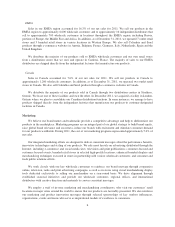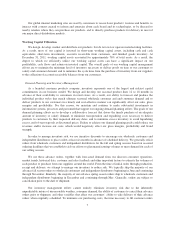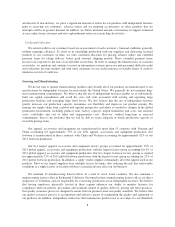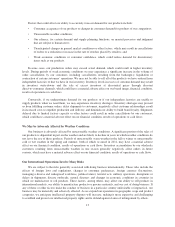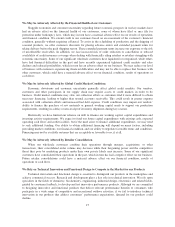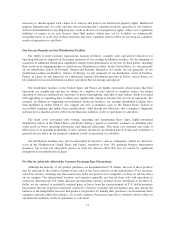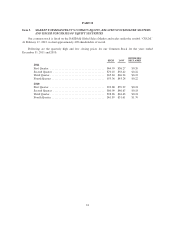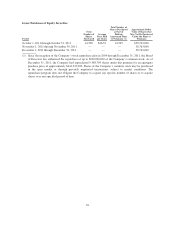Columbia Sportswear 2011 Annual Report Download - page 21
Download and view the complete annual report
Please find page 21 of the 2011 Columbia Sportswear annual report below. You can navigate through the pages in the report by either clicking on the pages listed below, or by using the keyword search tool below to find specific information within the annual report.As we strive to achieve technical innovations, we face a greater risk of inadvertent infringements of third
party rights or compliance issues with regulations applicable to products with technical innovations such as
electrical components. In addition, technical innovations often involve more complex manufacturing processes.
More complex manufacturing processes may lead to higher instances of quality issues, and if we experience
problems with the quality of our products, we may incur substantial expense to remedy the problems. Failure to
successfully bring to market technical innovations in our product lines could have a material adverse effect on
our financial condition, results of operations or cash flows.
We Face Risks Associated with Consumer Preferences and Fashion Trends
Changes in consumer preferences or consumer interest in outdoor activities may have a material adverse
effect on our business. In addition, changes in fashion trends may have a greater impact than in the past as we
expand our offerings to include more product categories in more geographic areas, particularly with the Sorel
brand. We also face risks because our business requires us and our customers to anticipate consumer preferences.
Our decisions about product designs often are made far in advance of consumer acceptance. Although we try to
manage our inventory risk through early order commitments by retailers, we must generally place a significant
portion of our seasonal production orders with our independent factories before we have received all of a
season’s orders, and orders may be cancelled by customers before shipment. If we or our customers fail to
anticipate and respond to consumer preferences, we may have lower sales, excess inventories and lower profit
margins, any of which could have a material adverse effect on our financial condition, results of operations or
cash flows.
Our Success Depends on Our Use and Protection of Intellectual Property Rights
Our registered and common law trademarks and our patented or patent-pending designs and technologies
have significant value and are important to our ability to differentiate our products from those of our competitors’
and to create and sustain demand for our products. We also place significant value on our trade dress, the overall
appearance and image of our products. From time to time, we discover products that are counterfeit
reproductions of our products or that otherwise infringe on our proprietary rights. Counterfeiting activities
typically increase as brand recognition increases, especially in markets outside the United States. Increased
instances of counterfeit manufacture and sales may adversely affect our sales and our brand and result in a shift
of consumer preference away from our products. The actions we take to establish and protect trademarks and
other proprietary rights may not be adequate to prevent imitation of our products by others or to prevent others
from seeking to block sales of our products as violations of proprietary rights. In markets outside of the United
States, it may be more difficult for us to establish our proprietary rights and to successfully challenge use of those
rights by other parties. We also license our proprietary rights to third parties. Failure to choose appropriate
licensees and licensed product categories may dilute or harm our brand image. In addition to our own intellectual
property rights, many of the intellectual property rights in the technology, fabrics and processes used to
manufacture our products are generally owned or controlled by our suppliers and are generally not unique to us.
In those cases, we may not be able to adequately protect our products or differentiate their performance
characteristics and fabrications from those of our competitors. Actions or decisions in the management of our
intellectual property portfolio may affect the strength of our brands, which may in turn have a material adverse
effect on our financial condition, results of operations or cash flows.
Although we have not been materially inhibited from selling products in connection with patent, trademark
and trade dress disputes, as we focus on innovation in our product lines, extend our brands into new product
categories and expand the geographic scope of our marketing, we may become subject to litigation based on
allegations of infringement of intellectual property rights of third parties, including third party trademark,
copyright and patent rights. An increasing number of our products include technologies and/or designs for which
we have obtained or applied for patent protection. Failure to successfully obtain and maintain patents on these
innovations could negatively affect our ability to market and sell our products. Future litigation also may be
16


